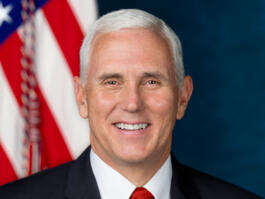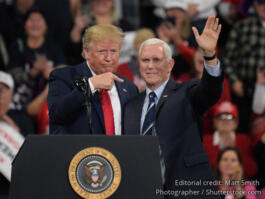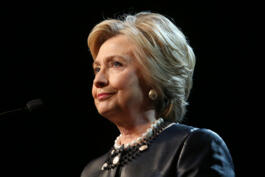A Few Pence Richer? Trump Picks a Running Mate
A Commentary By Larry J. Sabato, Kyle Kondik and Geoffrey Skelley
Our own sources in and around Gov. Mike Pence of Indiana have told us what everyone else has been reporting: He appears to be Donald Trump’s vice presidential pick. Still, to the best of their knowledge, the official call from Trump has not yet been made. We all know Trump is full of surprises, so we add this note of caution just in case. We all remember erroneous reports that John Kerry had selected Dick Gephardt as his running mate in 2004, when Kerry actually chose John Edwards. For our purposes here, we’ll assume it is true, that the GOP nominee for vice president will be Pence.
Despite the heavy focus on Pence and the eventual Democratic running mate, it’s good to remember that the vice presidential choice usually makes very little difference in the end. Well, that’s true for politics at least. For governing, the pick couldn’t be more important, since the VP is a heartbeat away from the Oval Office and is in the loop for most major decisions of any administration. But the last time a running mate may have really swung an election was 1960, when John F. Kennedy’s selection of Lyndon B. Johnson helped Democrats narrowly hold parts of the traditionally Democratic South, particularly LBJ’s home state of Texas. So while some running mates in the past five decades have helped or hurt a ticket, they have usually only benefited or hindered at the margins and have not proved decisive in and of themselves. We should expect that to be the case once again in 2016, particularly given the outsized personas nominated by the two major parties.
Few will believe what we’ve just asserted when the Veep-to-be is announced. The hoopla is overwhelming and the punditry overblown. But after the conventions, and except for a brief period surrounding the one vice presidential debate, voters hear little about the number twos — unless gaffes are committed — and people very seldom base their vote for president on anything the running mate has said or done.
The exception, of course, can be the VP’s home state, but it is remarkable how often that isn’t true or doesn’t matter. Edwards couldn’t carry North Carolina for Kerry in 2004, and Paul Ryan couldn’t win Wisconsin for Mitt Romney in 2012, just to cite two recent examples. Frequently, the VP nominee’s home state is already in the bag for his or her party — Dick Cheney’s Wyoming, Joe Lieberman’s Connecticut, Joe Biden’s Delaware, or Sarah Palin’s Alaska.
Political scientists generally don’t think running mates have much of an effect on election results. For example, one study found that from 1884 to 1984, a presidential ticket did only 0.3 points better than expected in the running mate’s home state. Another analysis, however, suggested that running mates are worth, on average, 2.2 points in the VP’s state. That might have mattered if Trump had picked John Kasich of Ohio, a popular governor who probably could have helped win that bellwether swing state. Indeed, Thomas Dewey’s selection of Ohio Gov. John Bricker in 1944 almost certainly pushed the state very narrowly into the Republican column (over Franklin Roosevelt during World War II), but FDR won the overall race comfortably. If Trump needs Pence just to win Indiana — and he probably doesn’t — he won’t have much chance of winning anyway.
Why Pence?
Considering Trump’s final shortlist included less-than-stellar options such as Gov. Chris Christie of New Jersey, former Speaker of the House Newt Gingrich, and Lt. Gen. (Ret.) Mike Flynn, Pence may be the best possible pick for Trump under the circumstances. A social and economic conservative with strong religious views and think-tank credentials, Pence could conceivably shore up some of Trump’s weaknesses among certain strands of the GOP base and some ideologically-committed conservatives inside and outside the Beltway. Pence also fits Trump’s oft-mentioned preference for a running mate who knows politics. The Indiana governor is familiar with the ins and outs of DC, having served six terms in the House of Representatives and two years as chair of the House Republican Conference. He is much liked in Congress on the GOP side, and Paul Ryan and company, who have serious doubts about Trump and don’t fully trust him, are relieved. They’ll have a point of contact in any Trump administration. Maybe the Pence pick earns Trump some goodwill in the establishment and suggests he’ll be more reliable than they think. Perhaps this will quiet some of the dissident voices in the GOP and assist in reunification (though we’re skeptics, for now).
The main question is, will Pence meet the foremost criterion for a running mate — do no harm? Of the available options — other, perhaps more attractive names recently removed themselves from consideration — Pence may be the safest pick for Trump. Christie would have doubled-down on Trump’s personality but wouldn’t have helped much with the base. Also, Christie could have distracted from Hillary Clinton’s scandals because of his “Bridgegate” troubles. Gingrich wowed Republicans in the 2012 cycle with his stage presence and anti-media attack-dog mindset, but he is gaffe-prone and might have chased the spotlight more than Trump wanted. Flynn would have brought hefty national security credentials to the ticket, but his political inexperience and uncertain views on other political issues were unwelcome question marks.
Still, some have suggested Pence may struggle in the limelight, particularly when it comes to defending Trump’s policy positions or controversies. (Pence is on record opposing Trump’s Muslim ban, for example.) Moreover, Pence’s work as a conservative talk-radio host during the 1990s might provide attack fodder. And while Pence is often described as being popular with social conservatives, his compromise on religious freedom legislation in Indiana may make that less true. It is worth noting that Trump has already consolidated 75%-80% of evangelical Christians — in line with the 78% of white evangelicals Romney won in 2012 — so one wonders how much Pence can add there. Some claim Pence is well equipped by geography to help Trump in Ohio, Michigan, and throughout the Rust Belt Midwest, but we question that, too. Voters in those states, to this date anyway, have likely never heard of Pence and have no special connection to him.
Pence’s tenure as governor has seen economic growth and increased employment. But his decision to sign Indiana’s Religious Freedom Restoration Act attracted national attention and controversy. Criticized as anti-gay, the law angered numerous corporations and organizations while also alienating some moderate Republicans. Bill Oesterle, cofounder of Angie’s List, even considered challenging Pence in the 2016 gubernatorial primary because of the new law. Having won renomination unopposed, Pence was due to face his 2012 Democratic opponent, John Gregg, in a November rematch. Some Indiana Republicans believe the state party is better off without Pence running for governor since the incumbent’s reelection was far from certain. Gregg may be the biggest loser in Pence’s VP selection because some of Pence’s potential replacements are less weighed down by baggage than the incumbent. On the other hand, Gregg gets to face an opponent who is not an incumbent and who, at least initially, might not have much name ID or money. So it’s unclear how the governor’s race might shake out, and we’re sticking with our Leans Republican rating as we wait and see who Pence’s replacement on the ballot is.
If it’s true that Pence would have been a weaker gubernatorial nominee than his replacement on the ballot, then how much does he really help Trump? Indiana, the most Republican state in the Midwest, should go to Trump unless the presumptive Republican nominee ends up losing by a sizable margin. Barack Obama very narrowly won the Hoosier State in 2008, which probably was something of a fluke, influenced by Obama’s advertising and ground game advantages over John McCain.
For a politician with presidential ambitions, it’s revealing that Pence decided it was better to take a chance running with Trump than continuing his reelection bid. Despite Trump’s underdog status, the Indiana governor must have decided this move offers the best chance of putting himself in the conversation for future presidential elections. This suggests Pence believes one of two things, or perhaps both: (1) Trump has a better chance of winning than many believe and/or (2) Pence’s odds of winning reelection are hurt by Trump being at the top of the ticket and that it’s better to take a chance with Trump than risk a reelection loss.
Indiana now becomes a focal point of the election. The state gave Trump a May primary victory that effectively ended the GOP nomination battle, and it delivered unto Bernie Sanders a victory that gave him some justification for continuing his challenge to Clinton through the remainder of the primary season. The state now has one of the two running mates, and the stunning late entry of former Sen. Evan Bayh (D) into the open Senate race makes Indiana a prime Democratic pickup opportunity and could be the seat that makes or breaks the Democrats’ potential majority. (We moved the Indiana Senate race from Likely Republican to Toss-up on Monday.)
Onward to Cleveland
We now head into the Republican National Convention at a fascinating point in the race. While Clinton will not face indictment over her email scandal, FBI Director James Comey’s criticism of the way she handled her private email server has led to some tighter national polls, although there is a lot of contradictory survey data now and Clinton still leads nationally.
Historically, conventions are an important moment in the campaign when both candidates have an opportunity to consolidate their bases. Trump and the Republicans go first, and even though the convention could be a disappointment or even a disaster, let’s remember that the recent bar for GOP conclaves is not high. For example, the 2012 Republican convention was something of a mess, marred by Clint Eastwood’s bizarre lecture to an empty chair and an ineffective message — built off Obama’s “you didn’t build that!” gaffe — that was targeted more toward a narrow audience of small business owners as opposed to the broader working public. Romney didn’t get much of a bounce from Tampa four years ago.
If next week’s unconventional approach works with the public, it is possible Trump will take at least a temporary lead in the polls. The burden will then be on Clinton to put on a good show in Philadelphia that can catapult her to a renewed lead, in addition to picking a running mate of her own. All of that remains to be seen.
For now, it’s Pence to Trump’s defense.
Larry J. Sabato is the director of the Center for Politics at the University of Virginia.
Kyle Kondik is a Political Analyst at the Center for Politics at the University of Virginia.
Geoffrey Skelley is the Associate Editor at the Center for Politics at the University of Virginia.
See Other Political Commentary by Larry Sabato
See Other Political Commentary by Kyle Kondik
See Other Political Commentary by Geoffrey Skelley
See Other Political Commentary
Rasmussen Reports is a media company specializing in the collection, publication and distribution of public opinion information.
We conduct public opinion polls on a variety of topics to inform our audience on events in the news and other topics of interest. To ensure editorial control and independence, we pay for the polls ourselves and generate revenue through the sale of subscriptions, sponsorships, and advertising. Nightly polling on politics, business and lifestyle topics provides the content to update the Rasmussen Reports web site many times each day. If it's in the news, it's in our polls. Additionally, the data drives a daily update newsletter and various media outlets across the country.
Some information, including the Rasmussen Reports daily Presidential Tracking Poll and commentaries are available for free to the general public. Subscriptions are available for $4.95 a month or 34.95 a year that provide subscribers with exclusive access to more than 20 stories per week on upcoming elections, consumer confidence, and issues that affect us all. For those who are really into the numbers, Platinum Members can review demographic crosstabs and a full history of our data.
To learn more about our methodology, click here.



